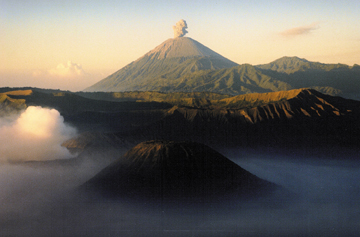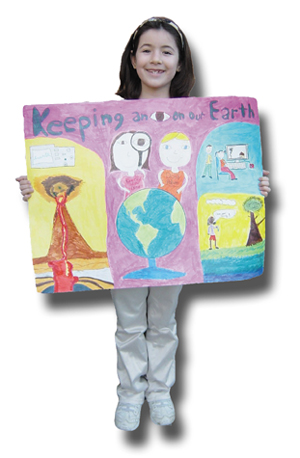Geotimes

Geoscience
Education & Outreach
Earth Science Week in the Limelight
Cynthia Martinez
October was a busy month for the earth sciences. Teacher Michael Wagner and
his science classes at Heritage High School in Leesburg, Va., collected cloud-observation
data as part of an intense observation period for NASA’s S’COOL (Students’
Cloud Observations Online) program. The Cleveland Museum of Natural History
hosted an “Antiques Rock Show,” where geologists were on hand to identify
rocks brought in by museum visitors. Students at the University of Dayton hosted
an earth-science career fair, guest lectures and a “geo-movie” night.
And fourth-grade students from the Tampa-St. Petersburg area in Florida visited
the U.S. Geological Survey (USGS) Center for Coastal and Watershed Studies to
explore the ways scientists monitor Earth.
All of these events marked the celebration of the sixth annual Earth Science
Week, held Oct. 12-18. Created by the American Geological Institute (AGI) to
promote understanding and appreciation of the value of earth science research
and its applications and relevance to our daily lives, Earth Science Week encourages
geoscientists to share their knowledge and enthusiasm about Earth with the public.
This year’s event celebrated the theme “Eyes on Planet Earth: Monitoring
Our Changing World.”
President George W. Bush officially recognized Earth Science Week and released
a presidential message on Oct. 10, applauding the efforts of scientists, educators
and parents to raise awareness about the importance of studying Earth. In addition,
at least 21 governors proclaimed Earth Science Week in their states.
To help facilitate planning, AGI distributed more than 11,000 Earth Science
Week information kits, which contained educational and outreach tools for teachers
and event organizers. Materials in the kits included NASA lithographs of satellite
images, the new AGI “Petroleum and the Environment” poster, a set
of classroom activities entitled “Tracking Change Through Time” from
USGS and the jointly produced USGS/AGI Global GIS North America CD-ROM.
Included with the CD-ROM was a guided activity to introduce students to the
use of powerful GIS software in earth science applications. Initial feedback
about the kits indicates that they are a high-quality resource for teachers
and geoscientists, who are teaching students and the public about the earth
sciences.
AGI also maintains a popular Web site dedicated to promoting
the week. Receiving more than 15,000 hits in October, the site includes information
about participating in Earth Science Week for geoscientists, teachers, students
and the media. It also includes a searchable database of events and a comprehensive
listing of events planned during the week all over the world.
This year, in all, leaders in the earth science community organized more than
200 events in all 50 states and in countries around the world as part of the
week. Earth Science Week even made it on television, with NASA airing a special
program, Virtual Earth, on Public Broadcasting Service stations and NASA
TV, in honor of the week.
In Tennessee, Gov. Phil Bredesen urged citizens to join him in the observance
of Earth Science Week. “In doing so, Governor Bredesen recognized the importance
of geology and other earth sciences in each of our lives,” wrote Tennessee
State Geologist Ron Zurawski. “From the role they play in supporting mineral
and water resources, preparing for and mitigating natural hazards, solving environmental
problems, and dealing with complex ecological issues, the earth sciences are
crucial to sound decision-making and effective stewardship of our natural environment.”
Contest
Winners
As part of Earth Science Week, the American Geological Institute organizes
four contests open to school-aged children and the public. These include
an art contest for elementary school children, an essay contest for middle
and high school students, a lesson plan design contest for educators and
a photography contest open to the public. The following winners received
cash prizes and subscriptions to Geotimes:
VISUAL
ARTS CONTEST:
Christina Gill, Herndon, Va., “Keeping an Eye on Our Earth” [see
sidebar below]
ESSAY CONTEST:
Jessica Taylor, Cary, N.C., “Who is a volcanologist and what do they do?”
 PHOTOGRAPHY
CONTEST: PHOTOGRAPHY
CONTEST:
Ben Kennedy, Montreal, Canada, “Tengar Caldera and Mt. Semeru, Indonesia”
LESSON PLAN DESIGN CONTEST:
Mary Ball, Jefferson City, Tenn., “Monitoring our Changing World: The USGS
Stream Gage Network” |
|
 Eyes
on Christina Gill Eyes
on Christina Gill
Eight-year-old Christina Gill from Herndon, Va., was the winner of this
year’s Visual Arts contest. A third-grade student at Cross Field
Elementary school, Christina already has a keen interest in learning about
the earth sciences. She may even become an earth scientist when she grows
up, following in the footsteps of her grandfather, who was a geologist
from Peru.
Christina is generously donating her cash award for winning the visual
arts contest to two fellow students so that they may attend the U.S. Geological
Survey summer camp next August. She met the two students while taking
science lessons from older Girl Scouts during the fall of 2003, and she
would like to help her classmates who could not otherwise afford to participate
in the science camp.
|
Getting involved
Are you wondering how you can get involved? The American Geological Institute
is already planning next October’s event. The theme is “Living on
a Restless Earth,” and will take place from Oct. 10-16, 2004. The restless
nature of our planet affects the global community every day. For example, earthquakes
rattle the islands of Japan, volcanic activity closes resorts in Italy, the
fishing industry in Peru struggles to survive changes in ocean temperature caused
by El Niño, and a sinkhole in the karst terrain in Florida causes the
sudden collapse of a building. Earth scientists study dramatic phenomena such
as these in order to understand their causes and minimize their impact on society.
Share your knowledge and enthusiasm about studying our dynamic Earth with others
by getting involved in Earth Science Week. To learn how, visit www.earthsciweek.org.
Martinez is the manager of the
Earth Science Week program at the American Geological Institute (AGI). Email:
cmm@agiweb.org.
AGI organizes Earth Science Week, with support from USGS, the American Association
of Petroleum Geologists Foundation, NASA and the National Park Service.
Links:
Earth
Science Week home page
 PHOTOGRAPHY
CONTEST:
PHOTOGRAPHY
CONTEST: 
 Eyes
on Christina Gill
Eyes
on Christina Gill